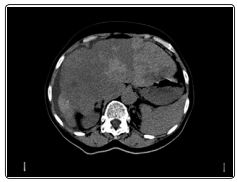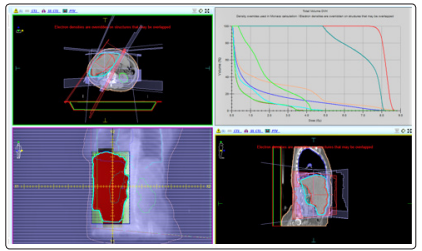Author(s): <p>Papa Macoumba Gaye<sup>*</sup>, Mouhamadou Bachir Ba<span style="font-size:10.8333px"> </span>and Ousseynou Sarr</p>
Hepatocarcinoma is the third localization of cancer in Senegal. More than 90 per cent of these cases in Senegal are painfull locally advanced stages. Radiotherapy is helpful in palliative situation. Newer radiation techniques, such as stereotactic body radiation therapy (SBRT) help reducing the radiation to nearby healthy tissues. This technique is not available in our institution. We report a case of 3D conformal total liver radiotherapy for locally advanced hepatocarcinoma.
Hepatocarcinoma is the third localization of cancer in Senegal (1). More than 90 per cent of cases in Senegal are painfull locally advanced stages (2). Radiation therapy may not be a good option for some patients whose liver has been greatly damaged by diseases such as hepatitis or cirrhosis. Although liver cancer cells are sensitive to radiation, much care is taken when planning the treatment to avoid damaging normal liver tissue. External Beam Radiation therapy (EBRT) can be indicated for: unresectable tumors, bad response after embolization, metastatic disease, thrombus blocking the portal vein and remaining pain after morphinic treatment. EBRT treatments are small doses of radiation given 5 days a week for several weeks in the curative situation or in single dose for palliative option. Newer radiation techniques, such as stereotactic body radiation therapy (SBRT) target liver tumors while reducing the radiation to nearby healthy tissues (3). These new techniques are note available in our institution. We report one case of total liver radiotherapy for hepatocarcinoma done by 3D conformal ( 3DCRT) techniques in Dalal Jamm hospital of Dakar.
We received on December 2019 a 65 old patient who present liver pain and loss of weight (10% in 3 months). Clinical exam found no ictera, moderate ascite, hepatomegaly (16 cm). Ultrasonography reveals a bulky liver mass (12 cm). CT scan revealed multinodular tumors of the right and left segment with a portal vein thrombus (fig 1).

Figure 1: Axial CT scan of a heteromultinodular hepatic tumor
Biological exam found: Haemoglobin is 14,7 g/dl, Transaminases (ASAT=134 IU/L, AFP=568 IU/L, Gamma GT =853IU/L, Alkaline phosphatase =489UI/L; and B positive hepatic serology. Fine needle biopsy guided by ultrasonography show an hepatocarcinoma .It is a stage IV unresectable tumor (T4 N0 M1). After 1 month of adaptative morphinic treatment, remaining permanent pain is quoted 8/10. Palliative Radiotherapy was indicated and the prescribed dose is 8 Gy. CT Simulation is done with 3mm cross sections from diaphragm to the hip bone. We treat with a 4-field 3 D conformal radiotherapy after dosimetry (fig 2).

Figure 2: 4 Fields technique of 3 D Conformal Radiotherapy

A total response on pain is obtained at 4 months. A marked improvement in his hepatic biological assessment was observed with ASAT at 19 IU / L, GGT at 230 U / L and alkaline phosphataseat 286 U / L) and a reduction in alphafoetoprotein at 3 months post radiotherapy to 59.7 IU / L . Patient died after 7 months.
The annual number of locally advanced and metastatic hepatocarcinoma deaths is equivalent to that of new cases, which means that the mean survival does not exceed not 1 year. 5-year survival all stages combined varies between 3% and 5% in cancer registries that track recorded cases (4). Pain occurs in 85% of patients seen in Senegal (2). Failure after opioid treatment is observed in nearly 25% of these liver tumors (5).Newer techniques such as stereotactic radiotherapy (SBRT) help preserving healthy tissues (3). The local dose constrains with stereotaxic radiotherapy are: 30 % receiving less than 60 Gy and 50 % of total liver less than 29.3 Gy. In conformational radiotherapy with or without intensity modulation, these dosimetric constraints are revised downwards without the risk of major hepatic toxicity. The efficacy and tolerance of radiotherapy in hepatocellular carcinoma has now been demonstrated, whether in curative treatment by conventional fractionation or under stereotaxic conditions, but also and especially in a palliative situation for pain and symptoms. 8Gy/1Fr palliative RT has shown promising evidence on symptom palliation in advanced hepatocellular carcinoma Tumor especially in symptoms, AFP response and median survival even if its efficacy in disease control and safety has not been reported . Resolution of pain after single dose of radiotherapy various from 50 to 70 % with a median duration of 4 months (6-9).
In locally advanced hepatocellular carcinoma, conformational radiotherapy optimized in single dose is effective in a palliative indication for pain, tumor control without increased hepatic toxicity.
